
Guide to growing avocado in Auckland clay soils
Growing avocados in Auckland’s predominately clay soil is notoriously hard but it is a fruit tree that many people would love to have at home.
Auckland Botanic Garden’s horticulturist Laurence Speedy has recently trialled a new approach in our Orchard using raised circular mounds secured by stakes and chicken wire.
Laurence hopes to keep the avocado’s sensitive tap root out of the soggy winter clay by raising the soil. When planted directly into clay soils avocados often do well for a year or two before declining rapidly.
Avocados need a higher content of air in the soil than most plants. They evolved in loose, well-draining soils in Central and South America and their roots are shallow and fibrous. Unlike many fruit trees that grow new roots throughout the year, avocado trees have distinct root flushes that coincide with shoot growth. This means their ability to recover from root damage can be slower than other trees.
Their roots also lack root hairs for efficient water uptake. Instead, they produce many fine feeder roots but these can make them prone to both drought and over-watering.
Laurence says the raised mounds are simple enough to make, you just need chicken wire, stakes, soil and mulch.
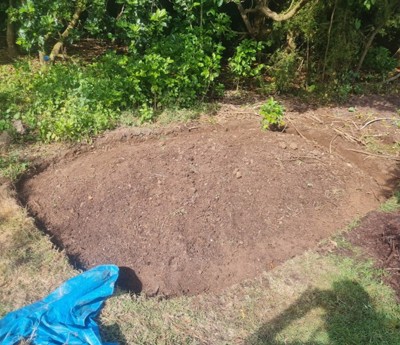
Start by marking out a circle of about 2m in diameter.
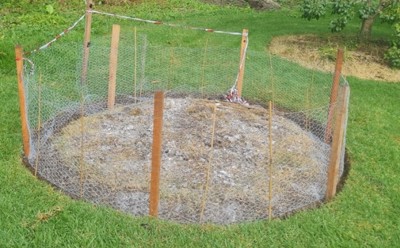
Place and secure 6 evenly spaced 1.5 m stakes around the circle perimeter.
Secure 20-25 mm gauge hexagonal chicken wire from stakes 1 to 6. Further secure chicken wire between stakes by threading and inserting bamboo canes.
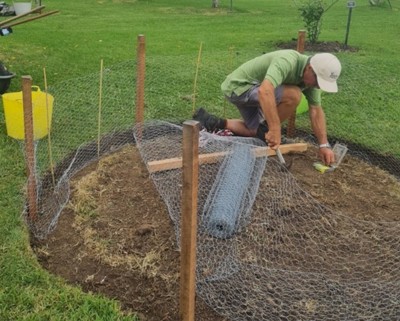
Now cut the chicken wire, allowing enough length to completely encircle the enclosure. This will mean that the cut end of the wire can be easily secured back to stake 1 – but do not secure this cut end back to stake 1 yet.
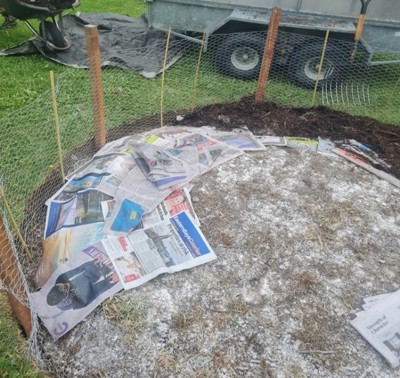
Next sprinkle gypsum on the enclosed area, to help break up some of the underlying clay.
Lay down cardboard or old newspapers to prevent weed growth.
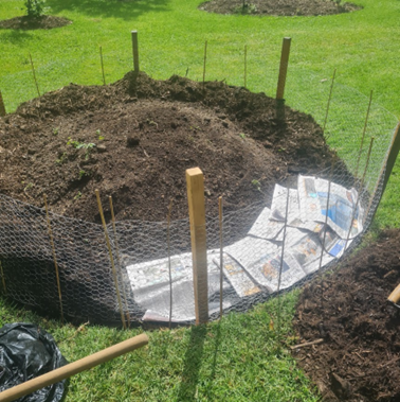
Now pile mulch up against the sides of the enclosure. Best mulches to use are megamulch or forest floor mulch, since they contain varying sizes of fines as well as shredded bark. When piled up against the sides of the chicken wire enclosure, these mulches loosely interlock and mat together. This allows a 20 -30 cm thick mulch wall to be formed immediately within the perimeter of the enclosure.
Initially, pile up mulch against the back and sides of the enclosure to form a horseshoe-shaped mulch wall as shown above.
Now pile good quality soil (consider incorporating pumice or perlite to improve air content) into the middle of the enclosure and up against the mulch wall.
Further raising of the soil level may be achieved by adding more mulch up against the chicken wire and soil into the middle.
Generally 60cm is a reasonable elevation.
Now secure the outer flap of wire back to post 1. This will completely enclose the circle with chicken wire.
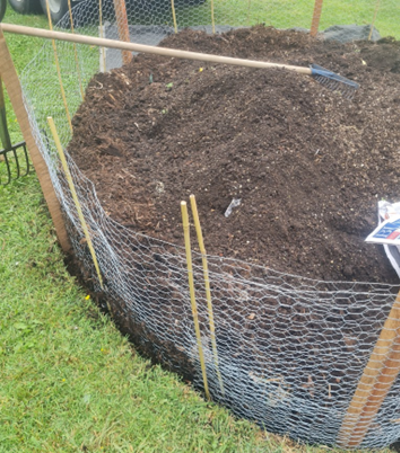
Pile mulch up against the remaining section of exposed chicken wire until a complete mulch wall encircles the inner perimeter of the enclosure.
Fill any remaining gaps in the centre with soil. Continue topping up with soil to reach an approximate elevation of 60 cm.
Mulch the soil surface on top of the mound (to about 12-15cm depth) leaving a gap in the centre to allow for planting.
Plant avocado in this gap.
Consider rehydrating the rootball prior to planting by immersing it in a bucket of water. Alternatively, the rootball can be immersed in a solution of phosphite (which may aid in the prevention of phytophthora).
Ensure the top of the root ball is level with the soil surface on top of the mound. Handle with care when planting and avoid excess root disturbance.
After planting, gently rake in the surrounding mulch so that it covers the top of the rootball. Taper mulch level down toward the plant stem to avoid mulch directly contacting the stem and leading to potential rot.
If planting during late spring/early summer, water the entire mound well.
Please be aware that planting on a mound will also mean watering more frequently during dry weather when the tree is still getting established (its first couple of years in the ground).
During dry spells, periodically check soil moisture level by simply pulling back mulch and gauging moisture level by feel.
Once established, an avocado tree can reward you with abundant fruit, so taking the time to prepare an area in the hope of successful establishment is worth the effort.
Good luck!
